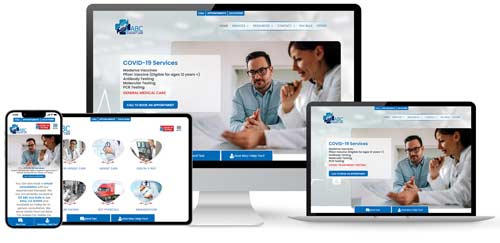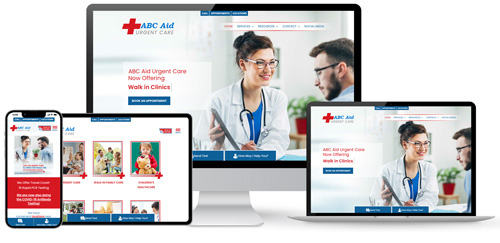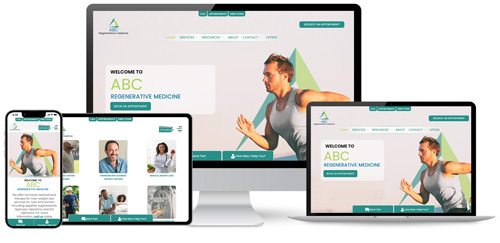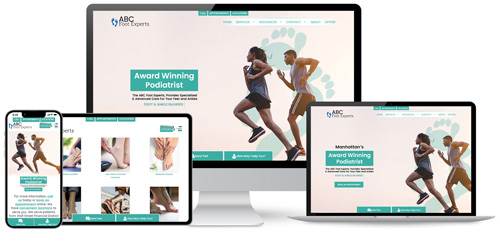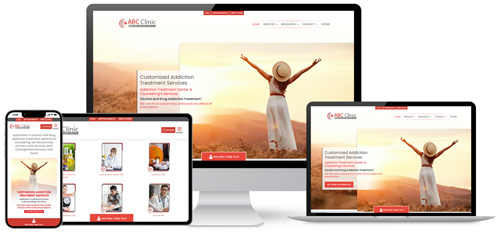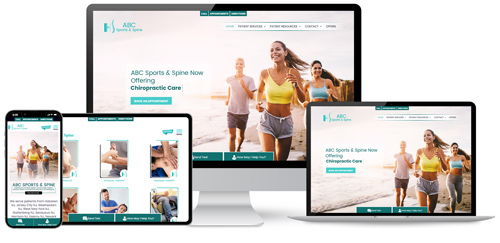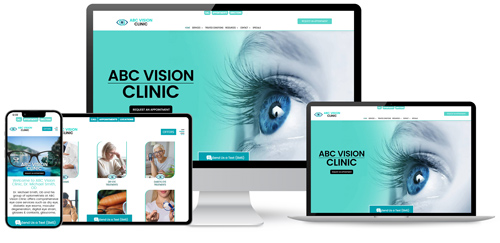Best Modern Website Designs For Doctors & Dentists 2025 Using WordPress
PatientGain offers HIPAA compliant website designs & ROI based healthcare marketing for dentists and doctors. WordPress high conversion medical and dental website with content is included with the GOLD and PLATINUM service, using latest responsive WordPress designs and mobile embedded apps. We can also create a one-time WordPress website for your practice, or we can improve your current WordPress site for a one time fee. In addition to a modern performing website, you also need excellent content. Modern medical websites with extremely high conversion rates focus on website SEO and website fast loading pages.

HIPAA compliance of medical and dental websites is critical for any healthcare practice. It is not an “optional” item. It is not only a requirement, but it is also good for your business.
Why high conversion medical and dental websites perform better than custom, one-off designs?
High-conversion websites, whether templated or custom-built with conversion principles in mind, generally outperform websites designed without focusing on converting visitors into patients. This is because high-conversion websites are A/B tested with specific strategy designed to guide visitors towards specific actions, such as placing certain actions on the website in specific areas. This focus on user experience and lead generation directly translates to practice growth and enhanced online presence.
Why you need fast loading healthcare website?
Pages that loaded in less than 3 seconds had a highest conversion rate, top tier. We measured mobile patients only, as majority of the patients visit your medical and dental websites from a iPhone or Android phone.
Pages that load in 3.1 to 4.0 seconds conversion rate dropped by 6 % from the top tier
Pages that load in 4.1 to 5.0 seconds conversion rate dropped by 19 % from the top tier
Pages that load in 5.1 to 6.0 seconds conversion rate dropped by 34 % from the top tier
Pages that load in 6.1 to 9.0 seconds conversion rate dropped by 61 % from the top tier
Pages that load in 9.1 to 12.0 seconds conversion rate dropped by 84 % from the top tier
More than 12 seconds, we did not calculate
Here is an example of Fast Loading Website : https://www.patientgain.com/
More Examples:


Read more about conversion rates and leads for medical and dental websites.
What is Fast WordPress?
Your healthcare practice mobile website should load within 4 seconds. Majority of your patients visit your website from a mobile device. As of 2021, Google reads your mobile website first, and if your mobile website loads slowly, it will start reducing your quality score and hence the rankings. Speed is now a landing page factor for Google Search and Ads. Fast loading medical & dental websites = more patients, read more. Medical website cache is also an important part of technical implementation of your website.
Case Study : Beautiful, nice website (non-optimized) – Before the Fast WordPress from PatientGain
Case study data : 1) Google performance rated at 35 score 2) Google accessibility rated at 81 score 3) Google best practices rated at 80 score 4) Google SEO rated at 80 score.
You can run tests on https://web.dev/measure/
Case Study : Beautiful, nice website (optimized) – After the Fast WordPress from PatientGain
Case study data : 1) Google performance rated at 96 score 2) Google accessibility rated at 98 score 3) Google best practices rated at 100 score 4) Google SEO rated at 100 score
When you run tests on https://web.dev/measure/ , enter your website URL, and run it 4-6 times. Then take an average. Remember that this is a tool provided by Google, as a simulator that is close to what Google’s actual search algorithms’ see. So our view is that it is a very good way of evaluating a website.
Common question asked by doctors and dentists, what determines the effectiveness of a website?
There are 9 specific areas to consider:
1) Is the website designed for your practice, and for your brand? Is it attractive?
2) Does the website cause the patient (potential or new patient) to take an action, called “conversion”?
3) Does the website provide useful information to a potential or new patient , called “content”? This is crucial for your SEO rankings also
4) Does the website work on all devices like, mobile, iPad, desktop?
5) Does the website load within 4 seconds or less?
6) Is the information collected from the website stored securely in a HIPAA compliant database?
7) Does the website have intelligence?
8) How is the technical structure of the website, is it designed for high SEO rankings?
9) Is the overall design of the completed website gone through A/B testing?
With PatientGain.com’s GOLD service, your healthcare practice gets a responsive medical website designed for patient conversion, worth $4,500 to $9,000 in value, at no additional cost. These sites are not cookie cutter sites, they are A/B tested with embedded apps for best conversion and optimized for Google SEO. We also offer custom websites, prices starting at $4500 for a one time fee for a single location practice.


PatientGain.com’s Medical Marketing Platform not only improves your clinic’s patient acquisition and engagement with intelligent apps, but also ensures your clinic’s web presence is professional and effective. Although the power of PatientGain.com’s solutions comes from our software powering your online medical marketing strategies, we also improve the cornerstone of your clinic’s online strategy: your website. See some examples below. Healthcare website design is included for free with the PatientGain.com GOLD service.
Medical & Dental Website UX Design Principles
When you read “Medical UX Design,” you may think this is some futuristic theory of website design. It is just short for “Medical Website User Experience Design.” Designing a website around the user experience is a great way to put together a useful medical site. To implement a UX design, you need to keep in mind:
• Clinic/Company Branding
• Functionality
• Medical Services Being Promoted
• Ease of Use
To accomplish these design goals, there are some areas you should put time into when designing your website. When PatientGain.com develops a medical website for our clients, we focus on these areas to create the best sites regardless of what field of healthcare they are involved with. Contact our experts today and let us evaluate your current website or propose a design to you that embraces UX concepts to turn your site into a useful tool for patient conversion. Read more about medical website ux design principles.
Fast Loading Medical & Dental Websites
Common question: How do I make my website load faster?
First, Why would you want to have a fast loading website for your medical practice? There are 2 main reasons.
- User experience. 82 percentage of patients who visit your medical website, do it from a mobile device. This data is from US and Canada only. If your website takes too long to load, they will not wait. Our conversion data shows that you have 14 to 15 seconds for a potential to take an action on your website and “engage”. So mobile website must load in first 4 seconds.
- Google’s SEO algorithms now read your mobile site first. So your mobile version of the website is actually more important than full desktop version. Even if you use responsive design, behind the scenes the algorithm of the responsive design template takes care of the details. Basically in the code of the template of your responsive design there are 3 main versions of your website. 1. Desktop version 2. iPad version 3. Mobile version. Read more here.
Medical Clinic Website Design Costs
There are many good companies who provide excellent service for your dental or medical clinic’s website design. They typically charge $4500 one time fee for website design, SEO, content. Monthly fees are additional. If you are paying $1000 to $3000, it’s probably someone learning on your account. Once the website is created, then you will need monthly marketing also. Learn more about marketing and advertising. Advertising is different from marketing.
Many dentists & doctors confuse advertising with marketing. Medical or dental marketing is much broader and advertising is a subset of your medical marketing strategy. Read more. You should market your practice, and you should have a budget to “advertise” your practice every month.
8 Important elements of your medical & dental website design:
1) It must be mobile optimized – Beyond mobile friendly.
2) It must be optimized for conversion and A/B tested.
3) Content must be fresh, relevant, on-topic, non-plagiarized.
4) SEO Optimized for Google search engine, with proper technical structure of the website for each page.
5) Based on WordPress (or other proven platforms).
6) Secure HTTPS and HIPAA compliant and ADA adherent
7) Should promote and build your brand.
8) Must be pretty, attractive and branded with your own brand.
Your website is the face of your practice. Don’t ignore it.
See some examples below. They are all based on real customers. Names removed.
All websites should be based on
A/B tested designs
Future of healthcare websites
Intelligence and HIPAA CRM
Don’t see your specialty? Very likely we have not added to this page. Here is the list of all specialties
Common Q&A from doctors, dentists and practice managers:
What is a high-performance healthcare website?
The website of any healthcare business will be one of the most critical marketing tools they have available to them. It is the one marketing property that practically all current and potential patients will interact with when searching for services. A practice that does not have a high-performance healthcare website will be at a severe disadvantage to competitors that deploy one. Patients take a much more hands-on role in their health care decisions today. It is far more common today for patients to select a health care practice without being referred first by another doctor. A high-performance website is needed to capture those potential patients.
A website of a healthcare practice needs to do many things at once. First, it needs to build trust between the potential patient and the practice. It needs to demonstrate expertise and authenticity and show a website visitor that they will be taken care of if they visit. It also often plays a role in educating website visitors. Depending on the nature of the practice, the target audience may not have a lot of practical knowledge about the treatments or services the practice offers. A website will then serve to bring them up to speed to clear up any questions or misconceptions. Finally, a website needs to convert visitors into patients with appointments to the practice. A high-performance website will have a high and reliable conversation rate to help practice succeed and grow. Below are some elements of a high-performance website.
Have the phone number of the healthcare practice visible and prominent on the website
Once a website has enticed a visitor to select it for its healthcare needs, the next step is to contact the practice. A phone number is one of the most common ways for a patient to contact a healthcare practice. The phone number needs to be displayed on every page of a website. Ideally, it should be in the “CALL” (header) area of the website and remain there even if a user scrolls down. A visitor should only glance up on a website page to see how to call the practice.
In the example below, you will that a mobile optimized has a “CALL” on the top. This is easily accessible to all users, and infact increaes conversion.

On mobile devices, the phone number should be linked so that if someone clicks on it that number will be automatically is sent to the phone to initiate a call. While on a desktop, it is easy for someone to look at the phone number and enter it into their phone. It is much harder to remember it, click out of the browser, open the phone, and then dial it in on a mobile device. Having the phone number linked makes it easy and will promote more calls from the mobile version of the website to the practice.
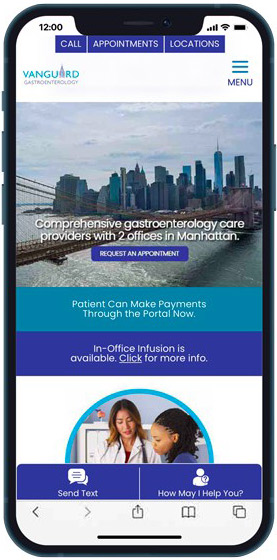
A high-performance website will also track how many phone calls are made from the website and how long those phone calls are with the staff. This vital information will tell a practice which pages on a site generate the most phone calls and how long phone calls are lasting with staff. If a page is generating high numbers of calls, it could indicate its popularity or that additional work is needed to clear up any questions. The length of a phone call can also help management determine if staff needs to be better trained to keep people on the phone and convert them to patients, or if there is some misconception causing people to call and quickly hang up.
Have multiple ways for patients to contact a medical practice and generate leads
While having a phone number on a website is undoubtedly a big first step, it should not be the only way for a current or potential patient to contact a practice or generate a lead for a practice to follow up on. A site can do several other things to make it easy for a patient to get in touch with a healthcare practice. Below are some everyday things health practices do to create a high-performance website:
Contact Forms – Not everyone is available to make a phone call during the business hours of a healthcare practice. Having the ability for a current or potential patient to submit a question via a form that gets sent to the practice to be addressed by staff is a great feature to have on a site. However, a practice needs to ensure it is HIPAA compliant. Any information submitted must be sent via a secure connection and stored on a HIPAA compliant server. This server must limit who has access to the messages and how those messages’ data is accessed or transferred and can be audited. A practice is responsible for all data sent to it, even if they didn’t ask for protected health information. While some practices may post an email address for site visitors to message, this can lead to high spam rates and not be HIPAA compliant.
Chatbots – Chatbots are another great way to make it easy for someone to contact a practice. They also play a significant role in cutting down phone calls to the front desks of healthcare practices and converting visitors into appointments. Chatbots help patients answer simple questions and accomplish tasks, like finding the online scheduling link. This assistance help get visitors the information they need faster and reduces delays in making appointments. Chatbots also can take a message if they can not immediately help a patient engages with it. Much like a contact form, it will take the visitor’s contact information, question and then store it on a HIPAA compliant server for staff to address later.
Online Survey or Quiz – Depending on the exact nature of a healthcare practice, some patients may not know they need a treatment or a specialist to assist with their ailment. An online survey and quiz can be a great way to engage with patients and get some leads to follow up with them later. A quiz or survey will ask a patient a series of simple questions and then let them know if it would be wise to seek out a treatment or specialist. At the end of the quiz or survey, there is usually a “request more information” form to fill out and submit their contact information. This goes (again) to a HIPAA compliant and secure dashboard where staff can then follow up with the quiz or survey taker and secure an appointment for them.
Use authentic photos from a healthcare practice and avoid using stock photos on a website to build authenticity
Actual photos of the staff, providers, facility, and treatment rooms where patients visit and receive treatments will only help create a high-performance healthcare website. While high quality and easy to use, stock photos do not carry the same weight as real photos from a healthcare practice. Many people can tell the difference between a stock photo and an actual photo of providers and staff. While stock photos certainly are helpful when launching a website or as a placeholder while authentic photos are in the process of being taken and worked into a site, a healthcare practice should always try to avoid stock photos.
However, using authentic photos of a healthcare practice does not mean any old photo will work for the website. Photos for the website need to be high quality, digital, clear, and well lit. A scanned photo printed at the pharmacy and used for the website’s home page is undoubtedly authentic, but it will not convey a sense of professionalism that people expect. If that is the very best a practice can do, then perhaps stock photos are the way to go. However, hiring a professional photographer to come in, set up scenes, and take pictures of the staff and facility should not be too expensive. While a practice can undoubtedly go overboard in spending money on a photographer, many cost-effective solutions exist.
When posting these new digital photos on the website, make sure they are optimized for the web. Raw pictures from a photographer will be entirely too large in file size to put on a website. While these photos will be great for print or outdoor advertising, which requires a high-resolution image, they do not perform well on the website. They will take a long time to load and reduce site speed, hurting the overall organic rankings. Large photos can especially drag down site speed and rankings on mobile websites. Optimized images will retain their high-quality and authentic feel and help create a high-performance healthcare website.
A website should build empathy with a patient
A high-performance healthcare website will not be a website that coldly lays out the treatments that are available and how to get in contact with a provider. High-performance websites make an empathetic connection with the website visitor. A site that can connect with a patient regarding their problems and feelings will perform better. They will motivate them to make the appointment and receive treatment.
Websites that show this empathy will talk about patient problems and how they feel on the home page of the site. They will describe the symptoms a patient could be experiencing and the hardships they are facing. If this content accurately reflects what current or potential patients face, it will make an excellent impression on them. They will see a healthcare practice that understands them and will take good care of them from their perspective. The more doubt that can be taken away that a healthcare practice is a right decision for them, the more likely they will make that appointment.
This kind of empathic language does wonders on other pages as well. It can generate leads from key pages that talk about the services offered in more detail. One should tailor the language to match the treatment or condition the page is talking about, but including that language can be an incredible boost to increasing the number of patients that visit a practice.
What are the qualities of modern website designs for doctor’s practice?
Modern medical practice website design revolves around a patient-centric approach, prioritizing user experience, trust-building, and functionality. Below is a comprehensive guide merging the essential qualities of effective medical websites:
1. User-Centric Design
- Intuitive Navigation: Clear menus, logical sitemaps, and easy-to-find calls-to-action (CTAs) guide visitors seamlessly through the site.
- Mobile-First Approach: Responsive design ensures optimal viewing and interaction across devices, including desktops, tablets, and smartphones.
- Fast Loading Speeds: Quick page load times reduce bounce rates and improve user satisfaction.
2. Building Trust and Credibility
- Professional Aesthetics: Clean layouts, high-quality images, and videos convey professionalism and care.
- Transparency and Openness: Provide clear details about services, insurance options, provider qualifications, and practice specialties.
- Patient Testimonials: Prominently display verified reviews and success stories to build social proof.
- Doctor Bios: Engaging profiles highlighting doctors’ expertise, experience, and human qualities foster patient trust.
3. Patient-Focused Content
- Informative and Engaging: High-quality, original content educates patients about health topics, medical procedures, and services.
- Easy-to-Read Language: Use simple, concise language that avoids medical jargon to ensure clarity for all audiences.
- Service pages: Maintain a regularly updated service pages with valuable health tips, news, and practice updates to keep patients engaged and informed.
4. Modern Features
- Online Appointment Scheduling: Offer seamless online booking systems for patient convenience.
- Patient Portal: Provide secure access to medical records, prescription refills, and communication with providers.
- Interactive Maps and Directions: Include easy-to-use maps and directions to help patients locate your practice effortlessly.
5. Accessibility
- ADA Compliance: Ensure the website adheres to Web Content Accessibility Guidelines (WCAG), making it usable for individuals with disabilities.
- Scalable Fonts: Allow users to adjust text sizes for better readability.
- Screen Reader Compatibility: Optimize the website for assistive technologies to accommodate all users.
6. Data Privacy and Security
- HIPAA Compliance: Protect patient data with secure forms, SSL encryption, and adherence to privacy regulations.
- Secure Online Features: Use encrypted portals for appointment booking, patient forms, and sensitive communication.
7. Enhanced Patient Experience
- Personalized Content: Display tailored health information based on patient demographics or search behavior.
- Telehealth Integration: Include telemedicine options for virtual consultations.
- Clear CTAs: Highlight action-oriented buttons like “Schedule Now” or “Contact Us” for easy navigation.
Conclusion
Modern medical practice websites must integrate design aesthetics, functionality, and compliance to attract and engage patients effectively. By focusing on user-centric features, trust-building elements, accessibility, and robust data security, medical practices can create websites that not only reflect their professionalism but also enhance the overall patient experience. The experts at PatientGain.com are available to help you create a high-performance healthcare website. Contact us and let us show you what we have done for other practices across the country!

